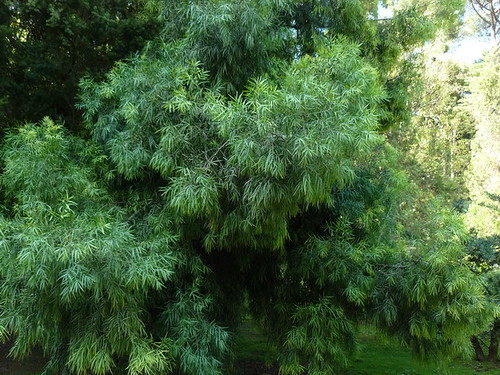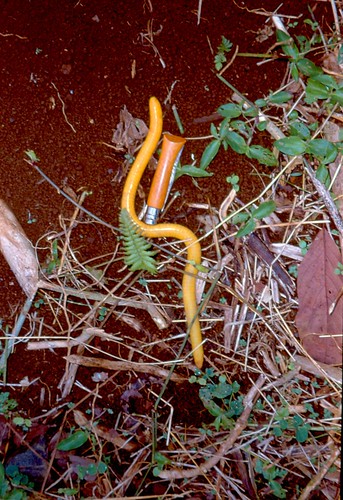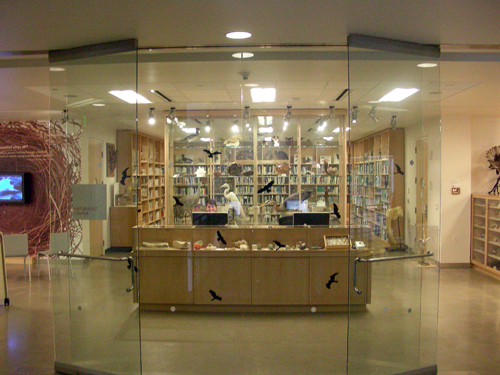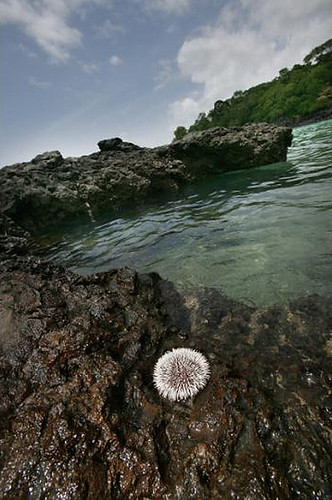Having just returned from Ethiopia, I am now “gearing up” for GG IV. If all goes well, we will be returning to the islands on the 19th of February for a month, thanks especially to continuing logistical support from our partner, Africa’s Eden (SCD), and the generosity of friends (see Partners below).
GG IV will be one of the smaller expeditions (four of us), due in part to financial constraints, but also because I have a particular, non-exploration focus in mind. But first the GG IV players:
Dr. Tom Daniel, is returning with us; as I mentioned in the last blog, he has just published a major paper on the island shrimp plants (his specialty) and along with more botanical exploring will be doing some technical pollination studies this time.

Dr. Tom Daniel on Sao Tome. RCD phot, GG III
Among our plans is a survey of the top of Pico do São Tomé which is at about 2000 m. None our previous expedition members has ever sampled the Pico so everything will be of interest, but our one of our special goals is to collect examples of Afrocarpus mannii, which is endemic to this mountain.

Afrocarpus mannii WWW. photo
This tree is a member of the yellow wood family (Podocarpaceae), and it is thought that all of its nearest relatives are found thousands of kilometers away in the East African highlands.

Distribution of Afrocarpus relatives. RCD construct.
This strange distribution pattern is showing up rather frequently in the various sorts of organisms we study (for instance, my frogs and reptiles) so we are always interested in testing these relationships using DNA technology; i.e., if these species are really closest relatives, what are they doing thousands of kilometers apart?

Dr. Shevock in Yunnan, China. Phot. D. Long - 2007
This is Dr. Jim Shevock, who recently joined the Academy faculty. Jim is one of the world’s foremost authorities on mosses. His latest book came out only a few weeks ago.

California Mosses. 2009. Micro-optics, New Zealand
Jim will be conducting the first comprehensive moss survey of São Tomé and Príncipe.

Dr. Shevock drying moss specimens. Phot. A. Colwell, 2009
Recall that when our expeditions began back in 2001, there were only four species of mushrooms known from the islands; as a result of GG II and III, Drs. Desjardin and Perry have identified some 225 species, including new ones. Phallus drewesii, an endemic to São Tomé, was just described in August. I have a strong suspicion that Jim Shevock is going to come up with similar surprises.
The other critter work will include hooking up with Jose Lima to obtain more shrew specimens and to find and identify the mysterious Charroco, the fish we missed on earlier expeditions and which is thus absent from the islands list. Jose is doing the research for his PhD with the University of Lancaster. Jose “rediscovered” the supposedly rare, possibly endemic São Tomé shrew, Crocidura thomensis. It is certainly not rare; as so often is the case, one just has to know where to look. Ricardo does. We have permission to collect a few and test their tissues to see if they are in fact true endemics, or whether they were brought to the islands via human activity.

"Cobra bobo" endemic to São Tomé. Phot. J. Juste
You will recognize this as the flamboyant caecilian, Schistometopum thomense or “cobra bobo,” known only from São Tomé. The photo was taken many years ago by my friend and colleague, Dr. Javier Juste of the Doñana Institute in Seville in Spain. Javier thinks he may actually have taken this photo on São Tomé, but he is sure that he has seen caecilians on Príncipe Id! This would be most exciting, and of
"Cobra bobo" endemic to São Tomé. Phot. J. Juste
You will recognize this as the flamboyant caecilian, Schistometopum thomense or “cobra bobo,” known only from São Tomé. The photo was taken many years ago by my friend and colleague, Dr. Javier Juste of the Doñana Institute in Seville in Spain. Javier thinks he may actually have taken this photo on São Tomé, but he is sure that he has seen caecilians on Príncipe Id! This would be most exciting, and of course we will be searching for them.
And now that we have found a myriapod (millipede) expert, Dr. Rowland Shelley of the North Carolina State Museum (see November post), we will be collecting these critters as well, and I have no doubt that this group will turn out to be as poorly known as the others…. More surprises in store.

A myriapod (millipede). www phot.
Now for the special focus. I have long thought that the citizens of the Republic of São Tomé and Príncipe need to be aware how absolutely unique and special their islands really are. My groups of scientists and I can continue to explore and conduct research and make neat scientific discoveries. We can continue to publish scientific papers, and we even add Portuguese abstracts. But while this is great for “Science”, the majority of Tomeans will never see these papers. This popular blog has been an attempt to “spread the word”, but the vast majority of the people there do not read English, and most certainly do not have computers. What good does all of our work and discoveries do if the citizens who live there are remain unaware of how special their islands are? For example, Martim Melo, an outstanding ornithologist and expert on the birds fauna of the islands has just established the fact that the islands of São Tomé and Príncipe, together, have the highest concentration of endemic bird species in the world! I doubt if anyone on the islands knows this fact, and think of what such a statement might mean to tourism! The people should know and be proud of the unique nature of their nation, especially because they will have hard decisions to make in the future, if and when the oil revenues come… that is why this blog is called the Island Biodiversity Race (go back to the first two postings, if you need to) – there is a real urgency to what we are doing.
So above and beyond our usual critter searches, I am going to spend a significant part of our time during GG IV meeting with various people who are involved in appropriate government ministries, education, tourism and the environment, in order to come up with ideas for a multi-level educational program. We hope to learn what the citizens want and need in this regard. This is where the fourth member of GG IV comes in: Mrs. Roberta Ayres.

Roberta Ayres (left) in the Naturalist Center, CAS. RCD phot. 2010
Roberta is Manager and Senior Educator of the Naturalist Center, which is a major part of the Koret-Taub Education Center of the Academy. Roberta has a Master’s degree in science education and, having been born in Brazil, speaks fluent Portuguese. Together, Roberta and I hope to learn how we can raise biodiversity awareness on the islands through our meetings and interviews with its citizens.

The California Academy of Sciences Naturalist Center. RCD phot. 2010
Barring technical or other problems, I plan to keep blogging from the islands.
The parting shot:
"Island Tranquility"- Laguna Azul, on Sao Tome. D. Lin phot. GGII
Partners
We gratefully acknowledge the support of the G. Lindsay Field Research Fund, Hagey Research Venture Fund of the California Academy of Sciences, the Société de Conservation et Développement (SCD) and Africa’s Eden for logistics, ground transportation and lodging, STePUP of Sao Tome http://www.stepup.st/, Arlindo de Ceita Carvalho, Director General, and Victor Bomfim, Salvador Sousa Pontes and Danilo Barbero of the Ministry of Environment, Republic of São Tomé and Príncipe for permission to export specimens for study, the continued support of Bastien Loloumb of Monte Pico and Faustino Oliviera, Director of the botanical garden at Bom Sucesso. Special thanks for the generosity of private individuals, George G. Breed, Gerry F. Ohrstrom, Timothy M. Muller, Mrs. W. H. V. Brooke, Mr. and Mrs. Michael Murakami, Hon. Richard C. Livermore, Prof. & Mrs. Evan C. Evans III and Mr. and Mrs. Robert M. Taylor for helping make these expeditions possible. Tax-deductable donations can be made to “CAS-Gulf of Guinea Fund.”